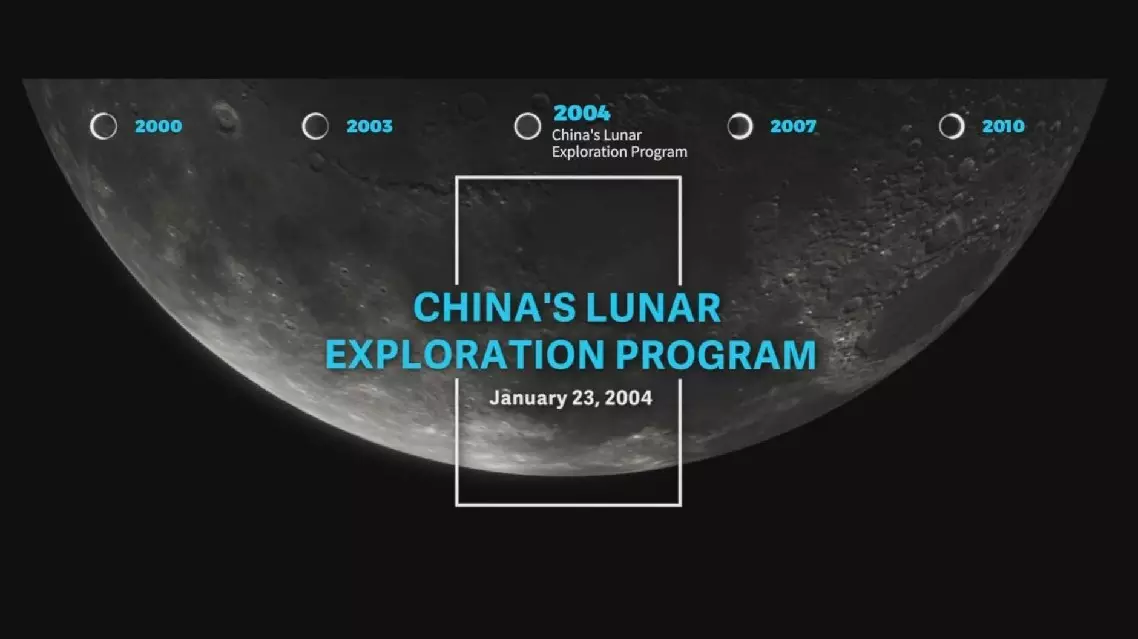China's 20-year three-step lunar exploration program, including orbiting, landing, and sample return, has marked a significant milestone in China and the world's lunar exploration efforts and sparked renewed confidence and hope for humanity's voyage into the boundless expanse of outer space.
The ascender of China's Chang'e-6 probe lifted off from the lunar surface on June 4, carrying samples collected from the moon's far side, marking an unprecedented feat in human lunar exploration history. As the Chang'e-6 probe embarked on its journey, it had almost 65 years to the day that humans first sent a probe to the moon.
In 1959, the Soviet Union launched the Luna 1 probe, the world's first lunar exploration satellite, which soared over 6,000 kilometers beyond the lunar surface, becoming the first flyby probe to reach the moon. This historic milestone was soon followed by the successful missions of Luna 2 and 3 in the same year, which accomplished the first-ever landing on the moon's surface and captured the images of the never-before-seen far side of our celestial neighbor.
A decade later, the historic Apollo 11 mission led by the United States successfully landed astronauts on the moon, marking a monumental achievement for humanity with Neil Armstrong's iconic words, "That's one small step for man, one giant leap for mankind."
In 1970, China launched its first man-made satellite, Dongfanghong-1, marking the country's first stride in exploring the vast expanse of the universe. This momentous event paved the way for China's subsequent advancements in space exploration.
In 2003, a momentous chapter in history unfolded as China launched its first manned space mission, Shenzhou-5, with Yang Liwei becoming the legend. As Yang delivered a greeting from over 300 kilometers above the Earth, China's ambitions had already set their sights on an even greater venture: lunar missions.
In 2004, China's lunar exploration program was officially named the Chang'e Program, derived from the revered moon goddess in Chinese mythology. It involved a three-step plan: orbiting, landing, and sample return. The first step was to develop China's lunar satellite to launch it into the moon's orbit.
In 2007, Chang'e-1, the country's first lunar probe, was launched from the Xichang Satellite Launch Center. While seemingly effortless, it is worth noting that nearly every country in the world faced initial failures in their lunar exploration endeavors. Chang'e-1 astounded the world by providing a comprehensive map of the moon's surface, unveiling previously unseen details.
In less than three years, Chang'e-2 entered a lunar orbit merely 100 kilometers from the moon. It provided a much clearer view of the lunar surface, capturing an image at an unprecedented resolution of seven meters, thereby producing the best moon map at that time. Besides, Chang'e-2 accomplished another groundbreaking feat by successfully capturing close-range images of the near-Earth asteroid Toutatis.
With the successful missions of Chang'e-1 and Chang'e-2, China was then poised for the next step: landing.
In 2013, Chang'e-3 achieved a successful soft landing on the targeted area in the northwest of Mare Imbrium. The landing site was named after China's Moon Palace, the fairytale home of the goddess Chang'e. China's first lunar rover Yutu, or Jade Rabbit, left its mark on the lunar surface as well.
For the subsequent lunar landing mission, China set its sights on an even more ambitious destination -- the far side of the moon.
Following the successful launch of China's relay satellite Queqiao to facilitate communications, the Chang'e-4 probe embarked on its journey. On January 3, 2019, Chang'e-4 landed in the Von Karman crater, marking humanity's first soft landing on the far side of the moon. Accompanying this historic milestone, Chang'e-4 carried the Yutu-2 rover to start its exploration of the uncharted territory on the far side of the moon.
As 2019 dawned, China stood on the precipice of its next lunar achievement, with just one year remaining until the anticipated return of lunar samples to Earth.
In 2020, the Wenchang Spacecraft Launch Site witnessed the remarkable ascent of a Long March-5 rocket, carrying the Chang'e-5 probe, from the sun-kissed coast of China's southern island province of Hainan.
Marking one of the most demanding missions in China's aerospace chronicles, Chang'e-5 became the world's first moon-sample mission in over four decades. The Chang'e-5 probe successfully retrieved about 1,731 grams of invaluable lunar samples, further solidifying China's position in lunar exploration history.
Four years later, a momentous event unfolded as the Chang'e-6 returner, carrying the world's first-ever samples from the far side of the moon, made a landing in northern China in June. This remarkable achievement signifies a significant leap forward in China's lunar exploration endeavors and ignites a renewed sense of hope for humanity's journey into the vast expanse of outer space.
A milestone in China's space exploration history, the Chang'e-6 mission not only embodies the ingenuity and efforts of China's scientists and engineers, but also exemplifies the country's commitment to open cooperation for the common interest of humanity.

China's lunar exploration program marks milestone in humanity's journey into space









